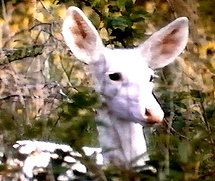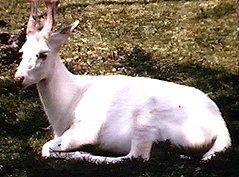- By Grey T. Larison
- Around Town
 Print
Print  Since the Federal government abandoned the 25 square miles that formed the Seneca Army Depot near Romulus, New York, a few years ago, several entities have been trying to find ways to utilize this land area. Industrial Parks with huge wads of money seem to dominate the top of the list.
Since the Federal government abandoned the 25 square miles that formed the Seneca Army Depot near Romulus, New York, a few years ago, several entities have been trying to find ways to utilize this land area. Industrial Parks with huge wads of money seem to dominate the top of the list. There is, however, a herd of white deer inside the perimeter fence that should be preserved. One group, Seneca White Deer, Inc, P.O. Box 226 Waterloo, New York 13165, has been trying to have a rather large area set aside as a natural preserve where the white deer can be nourished and protected. A nature center containing a herd of snow-white deer would attract tourists from across the nation, as well as foreign visitors, to Central New York.
One might wonder what is so special about white deer when the land could be used for purposes that are thought to be immediately more lucrative. Let me tell you what is so special about this herd of white deer. First and most important, they are NOT albinos that die off naturally almost immediately after birth.
Among those fawns born during the 1956 season were twin white doe fawns. Though white or spotted deer are not unusual throughout deer range, they are generally thought to be albinos, which have numerous physical problems and are usually sterile. In short, not worth serious scientific consideration. The white twins born inside The Seneca Army Depot in 1956 were different. These twins represented a new sub-species. They were immediately observed to dominate genetically, that is, when a white and brown deer mate, more than half the fawns produced from this union are solid white. Left on their own, white deer would breed the brown ones out. This means we were given, naturally, a new sub-species of white tailed deer that is certainly worthy of our consideration and protection.
Fortunately, the Base Commander at the time was trained, or had interest enough in natural science, to suspect an unusual event of great value had occurred. He placed the white deer under his "official protection". Official protection was necessary because hunting during the 50's was very heavy since the deer herd had grown so large the available range within the fenced Army Depot could not support them. Starvation and disease were destroying the entire herd; their numbers desperately needed to be reduced. A white deer is an easy shot for a hunter with a gun. With official protection, researchers noted within a very few years that a substantial portion of the deer herd had became white. Brown deer were loosing the genetic race for survival.
It became obvious white deer were going to breed out the brown ones within the Seneca Army Depot. It was then the New York State Department of Environmental Conservation, sensing an unusual research opportunity, began taking an interest in the herd. Research began.
 Several white deer of both sexes were captured, tranquilized and taken to Delmar, near Albany, where extensive blood samples were taken over an extended period. Through these tests, genetic dominance was determined. It was also noted that there were some differences in the whiteness of various individual deer. Some were pure white, dazzling in sunlight; others had a slight brownish or golden cast to them, depending on the season. It was discovered through this testing procedure, if a deer were homozygous (both parents white) the offspring would be pure white. If it was heterozygous, (one white and one brown parent) offspring were likely to have the brownish cast in the hair. Dark hairs are present during the winter months, while a lighter brown is the summer color.
Several white deer of both sexes were captured, tranquilized and taken to Delmar, near Albany, where extensive blood samples were taken over an extended period. Through these tests, genetic dominance was determined. It was also noted that there were some differences in the whiteness of various individual deer. Some were pure white, dazzling in sunlight; others had a slight brownish or golden cast to them, depending on the season. It was discovered through this testing procedure, if a deer were homozygous (both parents white) the offspring would be pure white. If it was heterozygous, (one white and one brown parent) offspring were likely to have the brownish cast in the hair. Dark hairs are present during the winter months, while a lighter brown is the summer color.
Researchers observed that the antlers on homozygous bucks were likely to be deformed. These deformities were not enough to give the animal problems during fall rut, but different in appearance to the human observer. Heterozygous bucks most likely would have what is considered a normally formed antler.
The DEC needed a good way to develop a research system to determine exactly how many doe should be removed each year from the States total deer herd. Overpopulation was and continues to be a constant problem in most areas of New York State. Biologists continue to question how many females should be taken from the herd to maintain the carrying capacity of available deer range. The answers to these questions were found with the white deer at Seneca army Depot. Scientists decided to maintain the white deer at one-third of the total herd, with 800 deer to carry through the winter. This was accomplished by determining the ratio of white to brown during the early fall months by "driving out" selected areas and counting the number of deer coming from each area selected. This gave biologists a statistical sampling of the total number of deer in the counted areas.
Later, after leaves had fallen and before snow arrived, the actual number of white deer was counted from a helicopter. From these numbers the total herd could be determined as well as the current ratio of white to brown deer. With these numbers game managers could set the number of brown and white deer to be removed during the harvest coming the later part of November. It was here the exacting program of issuing permits statewide to hunters for the taking of doe across the State was developed.
If we are to keep this unique herd of white deer, they need a land area that can be managed for them. They need a space large enough to support a viable herd, with accompanying protection and responsible management practices. Dennis Money, President of Seneca White Deer Inc conducts frequent tours of the land area proposed for a Nature Center. Contact him at the Waterloo address for further information.
Mr. Larison, a biologist and filmmaker, has produced more than 25 natural science films used in live lectures and sold via mail order to Public Schools in all 50 States for more than 25 years. He lives at North Lansing and continues nature photography in his retirement. His current project is a pictorial of area waterfalls.
----
v2i49



